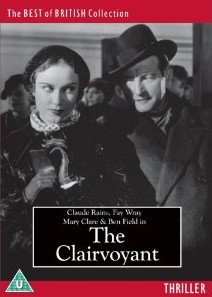'THE CLAIRVOYANT' (1935)

- A review by Richard Harrison (2011)
The very words “A Gainsborough Picture” produce in this writer a
nostalgic glow, inextricably linked as they are with the Will Hay films
he saw in his youth. The opening music combined with a refined lady
nodding delicately to the camera (and to me, it seemed)- set up
expectations which were always fulfilled, expectations of a warm, cosy
Britishness- usually connected with a light-hearted storyline full of
pleasant eccentricities and character actors. The Clairvoyant,
however, sweeps such cosy notions aside in favour of a strikingly stark
opening. A dramatic drum-roll accompanies a close-up of a man as the
light fades and he is plunged into silhouette. Then- the title of the
film appears, and we see that the man was no other than Claude Rains,
appearing in a low budget British film directed by the prolific (but
still relatively unknown) Maurice Elvey. Fay Wray’s name also appears
in the credits- yet another intriguing contribution to what is an
excellent little film.
To outline the plot of The Clairvoyant- Maximus (“King of the
Mind Readers”)’ put on “gift” actually comes true- is to denigrate a
beautifully made and finely acted film which is an intensely
atmospheric ride, at times almost Hitchcockian in its tension and red
herrings. This is perhaps not all that surprising, for the film brings
together an array of talent who worked with that great director. The
wonderful soft-focus cinematography for The Clairvoyant is by
Glen MacWilliams (who also shot Hitchcock’s under-rated classic Lifeboat
just over five years later). This not only maintains a strong emotion
throughout- particularly in those scenes set at night- but establishes
a highly aesthetic quality to what could have been a run-of-the-mill
thriller. The costumes (by Marianne), the music (by Louis Levy) and the
writer who adapted the film (Charles Bennett) also link to Hitchcock-
for all were involved in The 39 Steps made in the same year as The
Clairvoyant. The Hitchcock connection is not restricted to crew,
however. Donald Calthrop (who played Tracy in Blackmail (1929)
also appears, playing a similarly seedy role, albeit in a less
threatening way than he does in the Hitchcock film.
For all its age, The Clairvoyant does maintain the interest-
and the plot twists continue to astonish, as do the sometimes ambitious
set pieces. In a way, Maximus’ story could be seen as a satire on the
cult of celebrity- especially in the way it develops after the Humber
prediction, as, even now, the public at large are happy to have someone
to blame, someone to vilify. Thus, the focus of the film becomes a
timeless one, the only slightly uneasy note coming at the very end of
the film, though it is hard to posit what would have made a more
satisfactory ending given what had gone before.
For a generation used to the vulgarities of thrillers that must (by
necessity) have pounding music and often incoherent dialogue, The
Clairvoyant might look (and feel) like a museum piece. But, if you
look beyond the sometimes grainy images you will be amply rewarded. “A
Gainsborough Picture” meant something special in my formative years,
and still does now- in part thanks to films like The Clairvoyant,
which,
like Maximus’ prophecies, deliver what they promise.
'The Clairvoyant' is available on DVD from Odeon
Entertainment.
Odeon Entertainment website
Back
Home

